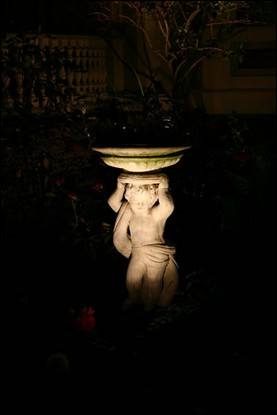Exterior lighting adds visual interest to your home and landscaping while highlighting safe walkways and paths. Photo courtesy of Wood River Evergreens. |
Exterior lighting involves much more than putting a lantern next to your front door and a light post at the end of the driveway. But before buying your lights, take a good look at your house and yard to determine what you want to accomplish.
Exterior Lighting for Safety
If safety is your main goal, identify which areas you use at night and any potential hazards, like dips, steps or lawn ornaments. Lighting the entryway is a top priority. Illuminate the steps, house number and door so you can easily get the key in the lock. Make sure walkways are well-lighted so no one trips on uneven ground, forgotten tools or toys. In snowy areas, lighting is key to avoid ice patches and potential slip and falls. The same rules apply to the garage area, driveway and deck. Use lighting to direct traffic to the safest routes by placing lights along the path you want people to follow to the garden or pool.
Research has confirmed that just having an area lighted helps deter crime, says Joe Rey-Barreau, a lighting designer, architect and professor at the University of Kentucky. Start by pinpointing the dark spots around your home that can serve as potential hiding places for thieves. “It’s a function of identifying where you feel uncomfortable,” Rey-Barreau says.
Keep in mind that light used for safety or security doesn’t have to be obtrusive or bright. “The solution can be much more subtle and much more elegant,” Rey-Barreau says. For example, you can use a technique called grazing to highlight the texture of your brick exterior and simultaneously illuminate the shrubs where a burglar might hide.
Exterior Lighting for Beauty
If showing off the beauty of your home is your focus, pick the features you want to highlight, like a carved door, graceful archway or unusual chimney on your house. You might also choose to spotlight yard features like a tree, pond, flower bed or statue. Creating attractive lighting is like a work of art. “It makes your house look wonderful and helps the resale value,” says Monty Gilbertson, manager of Lighting Design by Wettstein’s in La Crosse, Wis.
Different effects can be created by placing the light above, below, in front, behind or to the side of a subject. Up-lighting can make a tree glow in the summer and accent its bare branches in winter; down-lighting the tree can simulate dappled moonlight and create attractive patterns on the ground. Lights used to illuminate paths, steps and driveways usually shine downward to avoid blinding the walker.
Exterior lighting can be used for dramatic effects like highlighting significant exterior features or playing with light and shadow to create interesting patterns. Photo courtesy of Knight Light Custom Garden Lighting. |
Bulbs and colors also create varied effects. White, incandescent light is still popular for outdoor lighting. Don’t overuse colored lights or the effect may be gaudy.
Also avoid creating glare where light hits windows or light shines into visitors’ eyes or neighbors’ property. When creating special effects, try to keep the fixtures out of sight, but make sure the location doesn’t interfere with yard maintenance or bulb-changing.
Lighting Mistakes
Excessive light is a common mistake in exterior lighting of any kind. There is growing concern about the adverse environmental effects of light pollution, which can confuse animals and create a glow in the night sky that washes out the stars. “Dark sky” lighting techniques that include fixtures to direct the light downward and hide the bulb are becoming increasingly popular. Some communities even have ordinances requiring low- or no-glare lighting. Always try to use a minimal number of fixtures with the lowest-wattage bulb possible. “It’s remarkable what a 20-watt light bulb will do at night,” Gilbertson says.
When installing exterior lighting, try to look to the future. “Lack of planning is another big mistake,” Gilbertson says. Electrical codes require burying 120-volt cables two feet deep, so you want to lay the wires before you landscape or put in a driveway. Most landscape lighting is now done with 12-volt lights because they’re safer and the cable can be laid under mulch or topsoil. To use low-voltage lighting you will need a 120-volt, GFI-protected outside outlet and a transformer.
Style and Energy-Efficient Lighting Options
There are many styles of outside lighting fixtures to reflect your personal style. While fixtures were once made primarily of polished brass, many are now made from weather-resistant plastic or aluminum. Clear glass is becoming passé because it creates too much glare, while art glass is growing in popularity. Solar lights, which don’t require wires or electricity, are a smart choice.
There are also lots of options when it comes to energy efficiency. Timers and photo cells can turn lights on and off when you’re not home and motion detectors can activate them when an animal or intruder is present. They are energy-efficient in that they only use electricity when you need it, not constantly. Remote controls let you turn lights on at will or check out an unexpected visitor. Dimmers help create a special mood for outdoor gatherings while using as little light as possible.
Credit: Renovate Your World




























